
Catalog excerpts

Getting a New Lease on Life Cardiac Rhythm Therapy Patient’s Manual Getting a New Lease on Life 363403--B with an Implantable Cardioverter-Defibrillator 2011-X-40 BIOTRONIK SE & Co. KG Woermannkehre 1 12359 Berlin · Germany Tel +49 (0) 30 68905-0 Fax +49 (0) 30 6852804 patients@biotronik.com www.biotronik.com
Open the catalog to page 1
The Heart and Its Natural Rhythm 14 Heart Rhythm Disorders 20 When a heart beats too slowly: Bradycardia 20 When a heart beats too rapidly: Tachycardia 21 The ICD - Lifesaving Electrical Impulses 28 From external electrical shocks to 29 precisely controlled impulses The ICD: Providing the right stimulus for every 31 Antitachycardia and antibradycardia pacing 32 The ICD's individual components 4-0
Open the catalog to page 2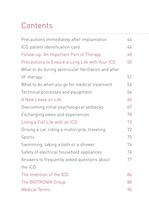
Precautions immediately after implantation 44 CD patient identification card 46 Follow-up: An Important Part of Therapy 4-8 Precautions to Ensure a Long Life with Your ICD 50 What to do during ventricular fibrillation and after What to do when you go for medical treatment 54 Technical processes and equipment 56 Overcoming initial psychological setbacks 67 Exchanging views and experiences 70 Living a Full Life with an ICD 72 Driving a car, riding a motorcycle, traveling 72 Swimming, taking a bath or a shower 76 Safety of electrical household appliances 76 Answers to frequently asked...
Open the catalog to page 3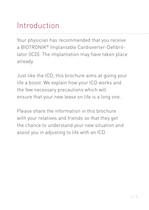
Your physician has recommended that you receive a BIOTRONIK® Implantable Cardioverter-Defibril- lator (ICD). The implantation may have taken place Just like the ICD, this brochure aims at giving your life a boost. We explain how your ICD works and the few necessary precautions which will ensure that your new lease on life is a long one. Please share the information in this brochure with your relatives and friends so that they get the chance to understand your new situation and assist you in adjusting to life with an ICD.
Open the catalog to page 4
The information in this brochure is not intended as a substitute for regular contact with your physician, whose instructions you should always follow. There is a blank page at the end of this brochure where you can write down any concerns or questions that arise during the time between your follow-up appointments. The ICD monitors your heartbeat and delivers electrical pulses when necessary. Therefore, it is the primary – and hopefully most frequent – task of the ICD to give you confidence that your heart is not beating too rapidly or too slowly on its own accord. You don't need to be...
Open the catalog to page 5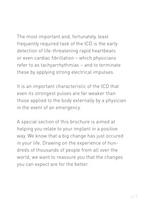
The most important and, fortunately, least frequently required task of the ICD is the early detection of life-threatening rapid heartbeats or even cardiac fibrillation – which physicians refer to as tachyarrhythmias – and to terminate these by applying strong electrical impulses. It is an important characteristic of the ICD that even its strongest pulses are far weaker than those applied to the body externally by a physician in the event of an emergency. A special section of this brochure is aimed at helping you relate to your implant in a positive way. We know that a big change has just...
Open the catalog to page 6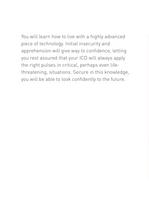
You will learn how to live with a highly advanced piece of technology. Initial insecurity and apprehension will give way to confidence, letting you rest assured that your ICD will always apply the right pulses in critical, perhaps even lifethreatening, situations. Secure in this knowledge, you will be able to look confidently to the future.
Open the catalog to page 7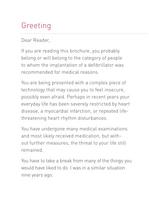
Greeting Dear Reader, If you are reading this brochure, you probably belong or will belong to the category of people to whom the implantation of a defibrillator was recommended for medical reasons. You are being presented with a complex piece of technology that may cause you to feel insecure, possibly even afraid. Perhaps in recent years your everyday life has been severely restricted by heart disease, a myocardial infarction, or repeated lifethreatening heart rhythm disturbances. You have undergone many medical examinations and most likely received medication, but without further measures,...
Open the catalog to page 9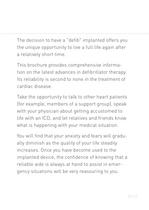
The decision to have a "defib" implanted offers you the unique opportunity to live a full life again after a relatively short time. This brochure provides comprehensive information on the latest advances in defibrillator therapy. Its reliability is second to none in the treatment of cardiac disease. Take the opportunity to talk to other heart patients (for example, members of a support group), speak with your physician about getting accustomed to life with an ICD, and let relatives and friends know what is happening with your medical situation. You will find that your anxiety and fears will...
Open the catalog to page 10
Your ICD will help you get a new lease on life, and you will be able to do more than you ever dared to do before. I wish you all the best for the future. Dieter Wetzel, Münster Chairman Herz in Takt Defi-Liga e.V. Support group for defibrillator patients
Open the catalog to page 11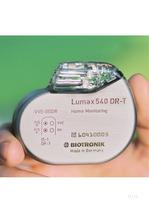
Home Monitoring
Open the catalog to page 12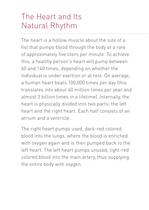
The Heart and Its Natural Rhythm The heart is a hollow muscle about the size of a fist that pumps blood through the body at a rate of approximately five liters per minute. To achieve this, a healthy person's heart will pump between 60 and 140 times, depending on whether the individual is under exertion or at rest. On average, a human heart beats 100,000 times per day (this translates into about 40 million times per year and almost 3 billion times in a lifetime). Internally, the heart is physically divided into two parts: the left heart and the right heart. Each half consists of an atrium...
Open the catalog to page 13
Left atrium Sinus node Right atrium Right ventricle Left ventricle Cardiac conduction system
Open the catalog to page 14
Heartbeats are caused by rhythmic contraction of the atria and ventricles. Every muscle fiber of the heart has the strength to contract on its own. The muscle fiber consists of cells, each of which has its own electrical charge. This charge is polarized, or ordered, by an electrical pulse. In a healthy person, this process is generated by a cell cluster inside the heart called the sinus node. These tiny electrical impulses generated by the sinus node trigger the heartbeat and regulate the sequence of the individual phases. From the node, the impulses flow through conductive tissue, which is...
Open the catalog to page 15All Biotronik catalogs and technical brochures
-
Orsiro
6 Pages
-
Pantera Pro
5 Pages
-
3Flow
2 Pages
-
PRO-Kinetic Energy
5 Pages
-
Magmaris
6 Pages
-
Passeo-35 HP
4 Pages
-
Pulsar-18
6 Pages
-
Galeo Pro
2 Pages
-
Fortress
3 Pages
-
Passeo-35
3 Pages
-
Passeo-18
3 Pages
-
Passeo-14
3 Pages
-
Conditions Overview
6 Pages
-
Closed Loop Stimulation
50 Pages
-
PK Papyrus
4 Pages
-
Astron
4 Pages
-
Pantera LEO
5 Pages
-
Lumax 740
1 Pages
-
BioMonitor
8 Pages
-
Protego
6 Pages
-
Idova 7
8 Pages
-
PRO-Kinetic
12 Pages
-
Magnum
2 Pages
-
Galeo
8 Pages
-
Streamer
2 Pages
-
AngioSculpt PTCA
2 Pages
-
BIOTRONIK Home Monitoring®
44 Pages
-
Pacemaker
48 Pages
Archived catalogs
-
Passeo-35 HP craking
3 Pages

































